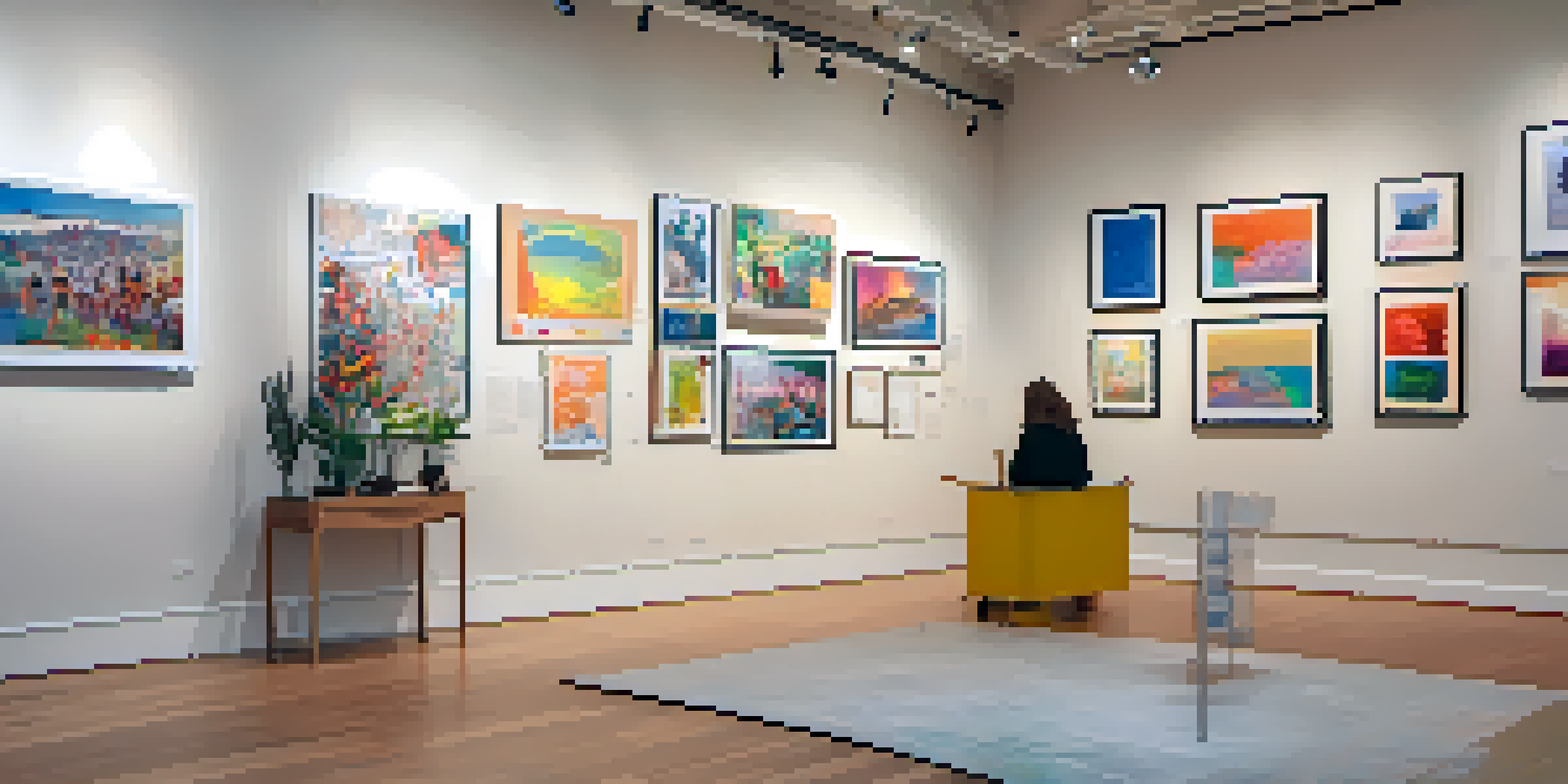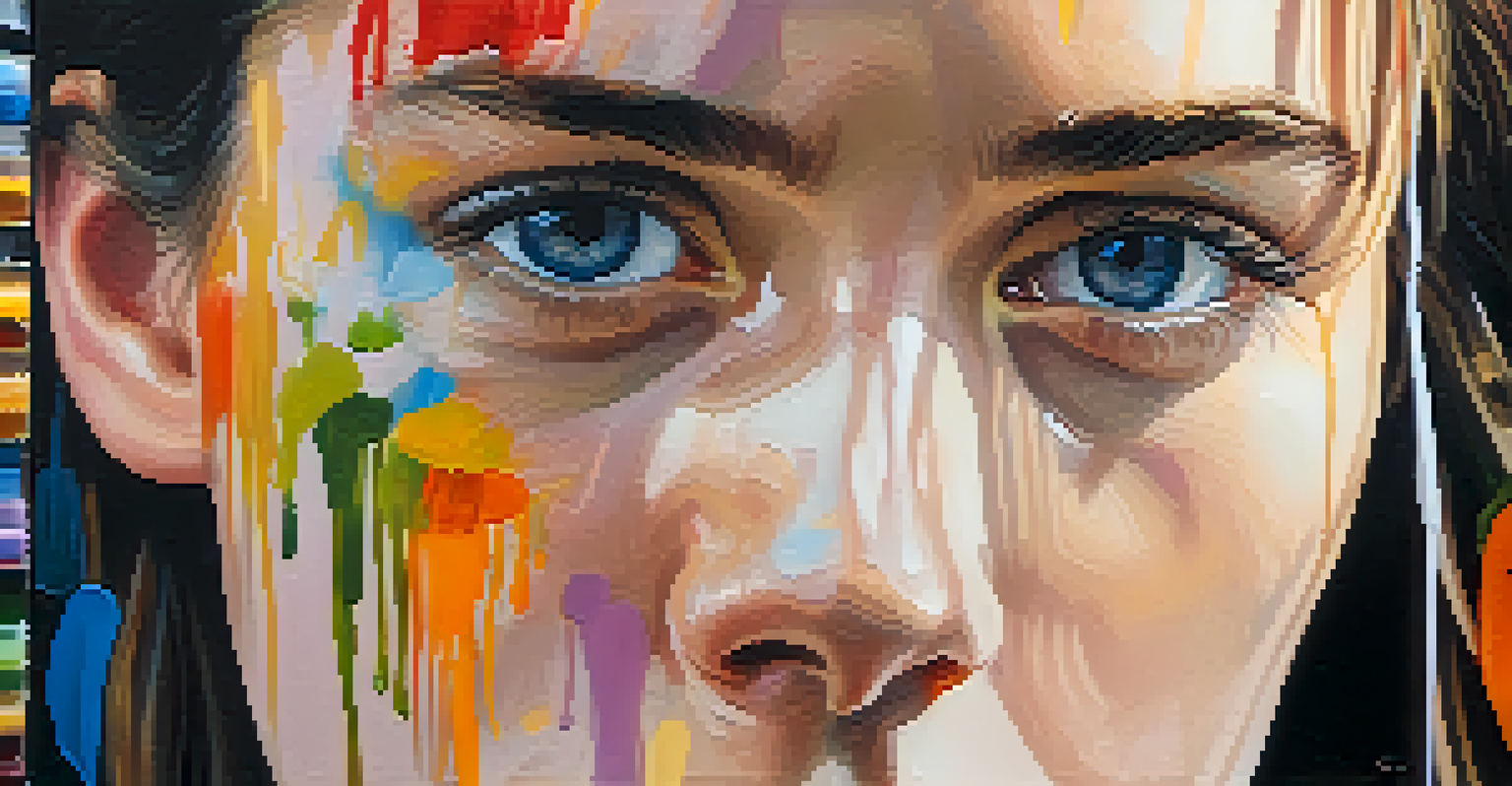Art Exhibitions: Raising Awareness for Mental Health

The Power of Art in Addressing Mental Health Issues
Art has long been a tool for expression, but its role in mental health is particularly profound. Through various mediums, artists can convey emotions and experiences that resonate deeply with viewers. This connection can spark conversations about mental health, making it less stigmatized and more relatable.
Art is not freedom from discipline, but disciplined freedom.
Consider the impact of a haunting painting or a moving sculpture. These works can evoke empathy and understanding, providing a window into the artist's mind. When we engage with art, we often find ourselves reflecting on our own experiences, which can lead to a greater awareness of mental health issues.
In this way, art acts as both a mirror and a bridge—reflecting our struggles and connecting us to one another. As exhibitions increasingly focus on mental health themes, they create safe spaces for dialogue and healing.
How Exhibitions Create Safe Spaces for Discussion
Art exhibitions dedicated to mental health often serve as safe spaces for viewers to explore their feelings. In these environments, individuals can confront their emotions without fear of judgment. This openness fosters a sense of community, encouraging attendees to share their own experiences.

For instance, when a gallery hosts an exhibition featuring pieces from artists who have battled mental illness, it invites visitors to engage on a personal level. Attendees may feel inspired to share their stories, leading to supportive conversations that can alleviate feelings of isolation.
Art as a Catalyst for Dialogue
Art creates connections and conversations around mental health, reducing stigma and fostering understanding.
These exhibitions not only raise awareness but also cultivate empathy among viewers. By normalizing discussions around mental health, they contribute to a culture where seeking help is seen as a strength rather than a weakness.
Artists Using Their Platform to Advocate for Change
Many artists are leveraging their platforms to advocate for mental health awareness through their work. By sharing their personal journeys and struggles, they help humanize mental health issues. This storytelling aspect of art can resonate powerfully with audiences, prompting them to reflect on their own mental health.
Creativity takes courage.
Take, for example, an artist who creates a series of self-portraits that depict their battle with anxiety. Each piece can capture a different facet of their experience, allowing viewers to witness the complexity of mental health. Such works not only raise awareness but also inspire conversations about personal and societal challenges.
As more artists embrace their roles as advocates, the art world becomes a vital space for mental health discussions. These efforts can lead to increased funding, resources, and support for mental health initiatives, ultimately benefiting society as a whole.
The Role of Interactive Art in Mental Health Awareness
Interactive art exhibitions, where visitors can engage with the artwork, play a unique role in raising mental health awareness. These installations often encourage participation, allowing attendees to express their thoughts and feelings creatively. This hands-on approach can make discussions about mental health feel more accessible and less intimidating.
For instance, an exhibition might feature a wall where visitors can write their feelings or share their mental health journeys. This communal act of expression can foster a sense of belonging and understanding among participants. It transforms the exhibition space into a shared experience, inviting connections and conversations.
Safe Spaces in Art Exhibitions
Exhibitions dedicated to mental health provide safe environments for individuals to confront their emotions and share experiences.
Through interactive art, visitors can explore their emotions in a safe environment, promoting healing and awareness. This engagement not only helps to demystify mental health issues but also encourages individuals to seek help and support.
Collaborations Between Artists and Mental Health Organizations
Collaborations between artists and mental health organizations can amplify the impact of art exhibitions. These partnerships often lead to events that combine creativity with education, providing valuable resources for attendees. By working together, artists and organizations can create a more informed public about mental health issues.
For example, an exhibition might feature artwork alongside informational booths from mental health professionals. This setup allows visitors to view art while also learning about available resources and support systems. Such collaborations can break down barriers between art and mental health services, fostering a holistic approach to awareness.
These joint efforts not only enhance the exhibition experience but also strengthen community ties. By merging artistic expression with mental health advocacy, they contribute to a culture that prioritizes mental well-being.
Success Stories: Exhibitions That Made a Difference
Many art exhibitions have successfully raised awareness for mental health, creating lasting change in their communities. One notable example is the 'Art for Heart' exhibition, which showcased works from artists affected by mental health issues. The event not only drew large crowds but also sparked meaningful discussions among attendees.
Feedback from participants often highlights how the exhibition helped them feel less alone in their struggles. Many reported that seeing the art and hearing the artists' stories encouraged them to seek help or talk about their own experiences. This kind of impact illustrates the power of art in fostering understanding and compassion.
Interactive Art Promotes Healing
Engaging with interactive art allows attendees to express their feelings, making discussions about mental health more accessible.
Such success stories are crucial as they demonstrate the potential of art exhibitions to effect real change. They inspire future events and encourage more artists to use their platforms for advocacy, ultimately contributing to a more compassionate society.
Future Trends: The Evolution of Art and Mental Health
As society continues to evolve, so too does the relationship between art and mental health awareness. Future exhibitions may incorporate technology, such as virtual reality, to create immersive experiences that deepen understanding. These innovations have the potential to engage audiences in ways that traditional exhibitions cannot.
Additionally, there is a growing trend of integrating mental health education into art curriculums. By teaching young artists about mental health issues and the importance of advocacy, we can cultivate a new generation of creators who are passionate about these topics. This proactive approach can lead to more impactful art that resonates with broader audiences.

Ultimately, the future of art exhibitions focused on mental health looks promising. As more people recognize the importance of mental health, the art world will likely continue to play a pivotal role in promoting awareness and fostering healing.